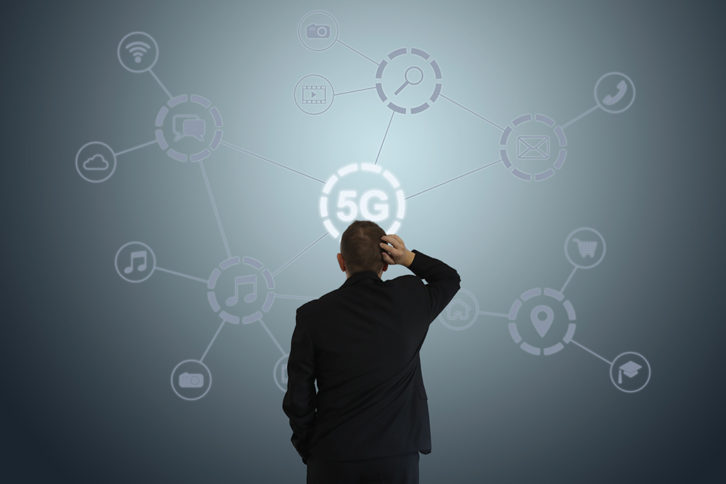
The problem facing broadcasters trying to capitalize on 5G-fixed-wireless is they don’t know what it is or isn’t yet.
Prior to this month’s CES show, Gary Shapiro, president/CEO of the Consumer Electronics Association, assessed the state of 5G for the Jacobs Media blog: “In 2019, 5G moved from trials to commercialization, with commercial launches in the U.S., Europe and Asia. By 2022, the majority (76%) of smartphones shipping in the U.S. will be 5G enabled,” Shapiro said.
“This year, 5G is capable of significantly greater data capacity for video and telepresence applications, significantly more connections at a time and ultra-low latency. The U.S. is now in a global race for 5G leadership, and connectivity — delivering anytime/anywhere access and information — and it is one of the driving trends of our time.”
And 5G’s potential content delivery powers continue to tantalize radio technical experts. Though the phase-in of 5G networks has begun, the full technical evolution is three to five years off, experts say. This leaves radio broadcasters time to think about ways to take advantage of the next-generation of cellular networks.
The new wireless platform will be superior to earlier generations of mobile systems, with significantly greater throughput and considerably lower latency, according to those who follow the sector.
Fifth-generation cellular technology is expected to have a transformative effect on multiple industries, including audio and video delivery. 5G is initially being deployed in mobile broadband networks alongside 4G/LTE, with stand-alone 5G deployments following at a later stage.
Technical experts say 5G — which was also the theme of several NAB Show sessions last year, and presumably will be again this spring — has the potential to transform how radio broadcasters operate, with enhanced wireless data transmissions and more data-intensive applications, and even point-to-point links.
The FCC continues to conduct 5G spectrum auctions, recently reallocating part of the C-Band spectrum for its use, which will be critical to the deployment of 5G services and applications. And broadcast equipment suppliers like transmitter manufacturers and codec makers reportedly are experimenting with 5G in order to explore the potential of next-gen wireless, even though industry standards have yet to be set.
The point-to-point communication capabilities of 5G could someday eliminate the need for traditional STLs and other high-capacity data circuits for broadcasters.
Much has been written about the implications on video, including virtual reality and e-sports, but the end game for radio depends on the timing of 5G full implementation, since the adoption curve for 5G is a few years from completion.
Observers say broadcasters need to approach 5G from both the standpoint of what it means for consumers and for how stations acquire and deliver content.
“As 5G networks become more ubiquitous, wireless technologies will be incorporated into more consumer devices, expanding the availability of streaming services beyond even where it is today,” said Ari Meltzer, a partner in the telecommunications, media and technology practice at Wiley Rein LLP.
“And because 5G signals have more bandwidth than traditional AM or FM signals, radio broadcasters should anticipate having to compete against the almost limitless variety of programming that will be available over 5G networks.”
Radio broadcasters would be wise to incorporate 5G into their long-term planning, Meltzer said, even if some guesswork is involved.
“Radio broadcasters need to analyze how listeners are consuming their content and how that is likely to change as consumer adoption of connected devices continues to grow at an exponential pace. While this may create challenges for the traditional linear programming model, it also creates opportunities for radio broadcasters to provide expanded interactive services and to reach listeners in new ways with new content,” he said.
The European Broadcasting Union’s project group 5G Deployments is addressing technical and non-technical issues related to business arrangements, deployment models and regulatory conditions for 5G mobile systems, according to Darko Ratkaj, EBU senior project manager for technology and innovation.

“Where available, 5G will provide improved connectivity with high speed and low latency, which would improve the user experience with audio streaming,” Ratkaj said. “However, streaming of audio services is already possible over 4G networks and WiFi, and this is increasingly popular. Therefore, the impact of 5G will be incremental, rather than revolutionary. Much will depend on the availability and performance of 5G-enabled user devices.”
In addition, one of the main benefits that 4G and 5G bring to broadcasters, Ratkaj said, is the “possibility to deliver content and services to personal devices, in particular mobile phones, which cannot receive signals via terrestrial or satellite broadcast networks.”
He added, “Content distribution over mobile networks such as 4G and 5G may require different commercial arrangements compared to conventional broadcasting.”
The connected car is expected to make use of 5G next-gen technology as the service rolls out; indeed the connected car is likely to hog a lot of its capacity.
A radio working group of the North American Broadcasters Association notes that 5G is often cited as the primary path forward for vehicle connectivity. “It is believed by many in the automotive space that 5G video application and vehicle-to-vehicle communication will use the majority of 5G’s capacity,” the committee wrote in its report “The Value Proposition of Radio in a Connected World,” published last year.
TOO SOON TO SAY
Technical observers say it is too early to begin architecting radio’s future with 5G but acknowledge the need for the industry to consider all opportunities to share audio and metadata in a better connected world.
“It’s difficult to answer the question about how radio as an industry may take advantage of what 5G has to offer. It’s an emerging technology, and geographic availability is yet to be defined,” said Michael Beach, VP of distribution at National Public Radio.
Milford Smith, principal with Smith, Khanna and Guill Inc., said while 5G is being rolled out by various carriers, some more aggressively than others, he thinks it’s going to take nearly ubiquitous availability before broadcasters explore new applications.
“One thing is for sure, it’s unlikely that there will be much need much longer for heritage wired pathways for out-of-studio events,” Smith said.
Another veteran engineer said how media is consumed will affect the efficiencies of using 5G next-gen services. “Audio is mostly consumed while mobile, whether jogging through the park or commuting to the office,” said Frank McCoy, CE at Salem Media Chicago. “Video is delivered more often to stationary devices. It’s a lot easier to maintain smooth connectivity through a single path than through an environment that requires regular system handoffs. This remains a limitation. The back end structure required to make this work will still struggle, I believe.”
As the small cell infrastructure in high-density areas for 5G is built out, the 5G canopy will expand, McCoy said.
“The new spectrum will linearly expand throughput per cell, but that’s it. To exponentially gain throughput requires more and smaller cells, so this isn’t a problem that’s easy to solve.”
There are technical implications of 5G adoption, too, McCoy said. “I expect 5G will look a lot like 4G but with more bandwidth. It’s still physics-limited to about 3.7 data bits per spectrum Hertz, though. And it may come without support for IPv4. Better study up on IPv6.”
McCoy said he is unaware of any 5G planning done by Salem Media, though fixed, point-to-point services should benefit from more bandwidth. “Then again, the Silicon Valley folks seem to come up with new, better consumer tools that require ever more bandwidth to function. And free connectivity may emerge, driven by ad content, as radio is,” he said.
There will be investment costs for broadcasters to be ready for the 5G world, said Richard Engelman, a technical consultant with Wiley Rein LLP.
“Given the variety of ways in which radio broadcasters can adopt 5G technologies, the range of required investments will vary tremendously,” he said.
“At one extreme, because 5G is a network technology that can be used to distribute a variety of content, radio broadcasters can invest in IP-based content distribution and take advantage of 5G without any incremental cost for 5G itself. At the other extreme, building new point-to-point links or equipping studios and remote facilities to take advantage of 5G technology will require both an upfront capital investment and, potentially, investments in the spectrum required to deliver the signal,” Engelman said.






